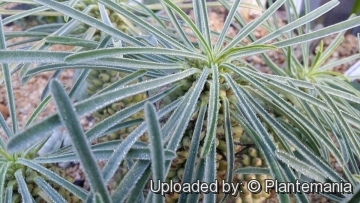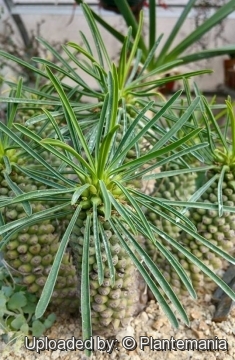




Your support is critical to our success.

Origin and Habitat: Euphorbia pubiglansSN|31775]]SN|31775]] is native to the Western and Eastern Cape Provinces, from the Uniondale District east to Port Elizabeth, South Africa. The species was described from the Port Elizabeth area, but has not been encountered there recently. It has possibly been wiped out by the expansion of the city at this site. It does, however, still occur on the Baviaanskloof Mountains and presumably westward beyond Uniondale toward Knysna.
Habitat and ecology: Coast regions and higher slopes of the Great Winterhoek. Mountains between Hankey and Steytlerville
Synonyms:
- Euphorbia pubiglans N.E.Br.
Description: Euphorbia pubiglansSN|21572]]SN|31775]] is a stout succulent herbs similar in habit to to Euphorbia bupleurifoliaSN|27159]]SN|17510]] but branching to form a rounded or conical shrub to about 30 cm tall. It can be distinguished from the latter by its taller habit, its persistent peduncles and the bracts which surround the cyathia forming a circular plate 25 mm in diameter. The stems are knobby, with spirally arranged tubercles. The linear leaves, whose blades are usually folded upwards are clustered at the stem tips. The three large, rounded bracts surrounding the cyathium are very striking in this species. There are actually five subtending bracts, but two are hidden behind the larger ones. E. pubiglans is a pretty succulent that is seldom seen.
Derivation of specific name: (Latin “pubiglans” = “hairy gland”) As the name suggests, the nectar glands are hairy on the upper side.
Stem: Succulent, spineless, simple or sparingly branched, 20-30 cm high, 3,5-4 cm thick at the base, where it is abruptly rounded into the root and gradually tapers upwards to 18 mm thick at the very obtuse apex, covered with densely crowded tubercles, glabrous, pale greyish-green on the young growth, becoming grey; tubercles crowded, arranged in ± 13 spirals, 4-5 mm in their greater diameter, and 3-6 mm in their lesser, rhomboid or 6-angled at the base, very obtuse, sub-hemispherical, 3-5 mm prominent. The tubercles of this species contrast with the less prominent hexagonal tubercles of Euphorbia clavaSN|21572]]SN|21572]] and the almost smooth, flattened tuberculate stems of Euphorbia bubalinaSN|17510]]SN|27159]].
Leaves: Glabrous, 18-37 mm long, linear, with margins inrolled or folded together and in that state about 1- 2 mm broad, glabrous.
Inflorescnce: Peduncles 2-6 cm long, semi-persistent, puberulous, with 3–5 small scattered lanceolate-acute bracts scattered along them and a whorl of 5 large bracts at the apex, forming a perfectly circular very flattened or plate-like cup 18-25 mm in diameter around and closely embracing the cyathium, glabrous except at the base around the cyathium, apparently purplish.
Flowers (Cyathia): Solitary; purplish, about 6 mm in diameter, minutely puberulous outside, with 5 glands and 5 rather large broadly rounded minutely toothed and ciliate lobes rising in a blunt cone 1-2 mm above them. Nectar-glands contiguous, 2.3 mm in their greater diameter, transverse, oblong, entire, distinctly puberulous on the upper surface along the outer and inner borders. Ovary subsessile, subglobose, slightly 6-angled, puberulous. Styles 1-2 mm long, united into a column for 1/3– 1/2 of their length, straight, at first slightly diverging, but scarcely exserted beyond the lobes of the involucre (cyathium), after fertilisation becoming parallel and closed together, quite entire at the apex, puberulous on the basal part.
Taxonomy notes: E. pubiglans is allied to Euphorbia clavaSN|31775]]SN|21572]], Jacq., for which it has probably been mistaken, as dried specimens of it have been distributed mixed with E. clava, but the manner in which the base of the upwardly tapering stem is abruptly rounded into the root, the much smaller, very crowded, tubercles, the shorter peduncles and straight and much shorter styles and the peculiar pubescent glands and ovary of the cyathium distinguish it. It is also a smaller plant.
Bibliography: Major references and further lectures
1) N. E. Brown, J. Hutchinson and D. Prain. “Flora Capensis” Vol 5, Part 2, page 216, (1925)
2) Alain Campbell White, Robert Allen Dyer, Boyd L. Sloane “The Succelent Euphorbisae (southern Africa)” Abbey garden Press, 1941
3) Urs Eggli “Illustrated Handbook of Succulent Plants: Dicotyledons” Volume 2. Springer, 2002
4) James Cullen, Sabina G. Knees, H. Suzanne Cubey “The European Garden Flora Flowering Plants: A Manual for the Identification of Plants Cultivated in Europe, Both Out-of-Doors and Under Glass” Cambridge University Press, 11/Aug/2011
5) The Euphorbia Journal Strawberry Press, page 69, 1994
6) Alain Campbell White, Robert Allen Dyer, Boyd L. Sloane “The succelent Euphorbisae (southern Africa)” Abbey garden press, 1941
7) Doreen Court “Succulent Flora of Southern Africa” CRC Press, 01 June 2000
8) Werner Rauh “The Wonderful World of Succulents: Cultivation and Description of Selected Succulent Plants Other Than Cacti” Smithsonian Institution Press, 1984
9) Kew Bulletin, Volume 30, page 44, H.M. Stationery Office, 1916
10) Cactus and Succulent Journal, Volume 81, Ed. 1-6 2009

Euphorbia pubiglans Photo by: © Plantemania

Euphorbia pubiglans Photo by: © Plantemania
Cultivation and Propagation: This is a small, slow-growing choice Euphorbia, and although not one of the easiest to grow, it should not be too difficult for the careful collector. It is suitable as a container plant (but it can grow in the ground in areas with a mild climate).
Soil: It grows well in a very draining mineral potting substrate.
Moisture: It does not like its compost drying out for very long periods when the weather is hot. It needs constant moisture during the Summer, but it doesn't like winter water, as it rots easily.
Hardiness: It needs to be kept warm, not less than 10 C in the winter (but when dormant and dry they are relatively cold tolerant).
Sun Exposure: Light shade.
Warning: The latex of the "Euphorbia pubiglansSN|31775]]SN|31775]]" is highly poisonous and can be very dangerous, depending on the dose given.
Propagation: Usually by seeds.
| Your Actions | |
|---|---|
| Back to Euphorbia index | |
| Back to Euphorbiaceae index | |
 |
Back to Succulents Encyclopedia index |
Privacy stantement - Terms and conditions - How to cite - About us - Feedback - Donate



